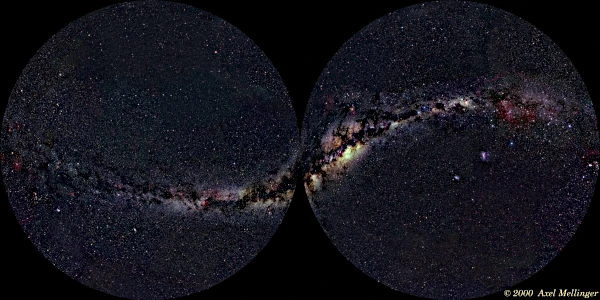
Image description: The Milky Way viewed from both Hemispheres of Earth, North on the left and South on the right of the image. The center of the Milky Way (bright part) is not visible from the northern hemisphere. The galactic center is located in the direction of the constellation Sagittarius, which is mainly visible from the southern hemisphere. Image source: Sky panorama by Axel Mellinger (German physicist).
The Milky Way is the barred spiral galaxy in which our Solar System is located. It is composed of 100 to 400 billion stars, gas, dust, and other celestial objects. The immense size of the Milky Way, the "edges" of the galaxy which are not clear boundaries, and natural obstacles like interstellar dust make it very difficult to obtain an exact number of stars in our galaxy.
In the northern hemisphere, the Milky Way is visible mainly during the summer months. It appears as a luminous band crossing the night sky. The most remarkable constellations for observing the Milky Way in the northern hemisphere include Cygnus, Aquila, and Cassiopeia.
The center of the Milky Way is not easily visible from the northern hemisphere due to several factors related to the observer's geographical position, the Earth's tilt, and the location of the galactic center in the sky.
The center of the Milky Way is located in the constellation Sagittarius, at a declination of about -29° (in the equatorial coordinate system). This means it is relatively close to the celestial equator but still in the southern celestial hemisphere. Therefore, the farther north an observer is located on Earth, the lower this celestial object will be on the horizon or completely below it, depending on the latitude.
The Earth's rotational axis is inclined about 23.5° relative to the ecliptic (the plane of the Earth's orbit around the Sun). This influences the visibility of celestial objects depending on the seasons.
The observer's latitude plays a critical role. The closer you are to the Earth's equator, the more you can observe the southern sky. Conversely, the farther north you are, the more the field of view is limited to the northern celestial hemisphere.
Even if the galactic center is technically visible at certain latitudes, its low altitude on the horizon means it is often affected by:
When the Sun is on the other side of the galactic disk, i.e., every 230 million years (galactic year), this does not change the visibility of the galactic center between the northern and southern hemispheres. The visibility of a specific region of the sky, such as the galactic center, is determined primarily by the Earth's relative position in its orbit and the inclination of its axis, not by the position of the Sun within the galaxy.
In the southern hemisphere, the Milky Way is visible almost all year round, but it is particularly impressive during the winter months (from June to August). The key constellations for observing the Milky Way in the southern hemisphere include Centaurus, the Southern Cross, and Scorpius.
The luminous band of the Milky Way is particularly bright and well-defined in the southern hemisphere. It stretches across the sky, offering a spectacular view of the spiral structure of our Galaxy.
Observers in the southern hemisphere have the advantage of being able to see the galactic center of the Milky Way, which is rich in stars, nebulae, and star clusters. Sites like the Atacama Desert in Chile or Australia offer exceptional observation conditions. Australia is an excellent place for astronomical observation due to its vast remote areas with little light pollution (Uluru, Alice Springs, Warrumbungle National Park, Coober Pedy, Kakadu National Park, Karijini National Park, and Tasmania).
The center of the Milky Way, located in the constellation Sagittarius, is well visible and high in the night sky. It is one of the richest regions in stars and interesting celestial objects.
Whether you are in the northern or southern hemisphere, observing the Milky Way is an unforgettable experience. By choosing the right time and place, you can admire the beauty and complexity of our Galaxy.